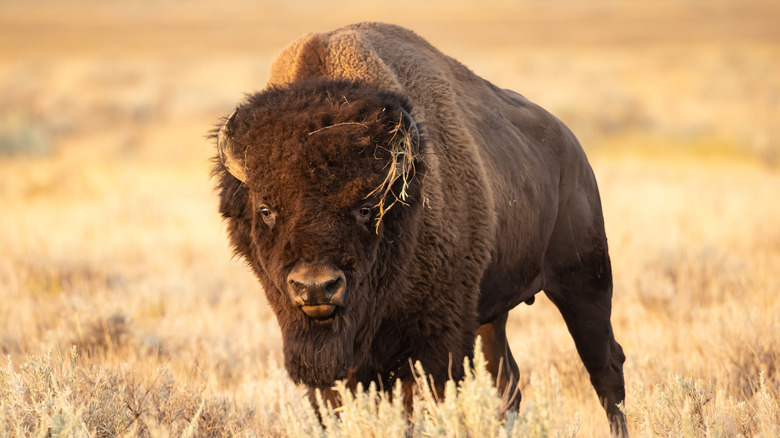Are Bison Dangerous? (And What To Do If You Encounter Them In The Wild)
For most people in North America, the closest encounter they'll have with a bison is between two buns at a fancy burger joint. Any live ones are most likely charging across the screen in a film, TV show, or documentary. Those stepping into wild bison turf — largely in the Great Plains — need to take special care, or they might bring home punctures and bruises along with the selfies and souvenirs. Unfortunately, that's a painful lesson learned by ever more national park visitors, including a Florida man gored at Yellowstone National Park in May 2025. Situations like that (and other upsetting tourist mistakes in Yellowstone National Park) lead the National Park Service (NPS) to repeatedly warn people about bison.
Wild bison are not as cute and cuddly as they appear. They are dangerous animals when provoked. Measuring up to 2,000 pounds and 6 feet tall, the bison is the largest mammal in North America. Add the momentum created by charging 35 miles per hour and a pair of sharp, curved horns, and nothing can stand in a bison's way. These animals are also touchy about personal space, and any transgressors may pay a punishing price. Multiply that danger by many times when bison travel with a herd, as a threat may set them all in motion at the same time.
Learn how to stay safe around bison
Bison safety starts with respect. That means giving them as wide a berth as possible, at least 100 feet, according to the NPS. Upon encountering a bison, retreat calmly and don't run, as that can startle and trigger the animal. Plus, bison run three times faster than humans and will win any long-distance sprint. As you gain distance, watch for behaviors like snorting, bellowing, pawing the ground, and bobbing the head, which often signal a charge. Head to places nearby that can offer protection, too — a car, boulders, trees, or other cover. Trailing bear spray may also help dissuade pursuit, so long as the wind is blowing in the bison's direction.
However, the best thing you can do to avoid becoming talk show fodder is to educate yourself before any journey into bison country. The more you know, the safer you become. You'll learn, for example, that bison get particularly protective May through August, during the rutting and calving seasons. So, when exploring the best parks where you can see bison roam, avoid these months to stay safe. Also keep this in mind when considering the best times of the year for a trip to Yellowstone National Park.
Another key lesson is that a good offense makes a better defense. Let the bison know you are coming and make noise as you go. Keep the earbuds off, too, or the last voice you ever hear could be a podcaster's.

